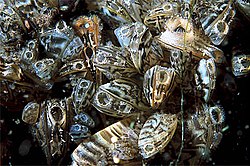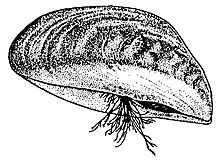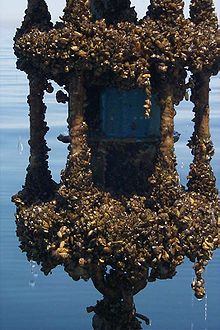Zebra mussel: Difference between revisions
| Line 58: | Line 58: | ||
[[file:Zebra mussel warning sign.jpg|thumb|Sign advising boaters on how to prevent zebra mussel spread on [[Titicus Reservoir]] in [[North Salem, New York]]]] |
[[file:Zebra mussel warning sign.jpg|thumb|Sign advising boaters on how to prevent zebra mussel spread on [[Titicus Reservoir]] in [[North Salem, New York]]]] |
||
The native distribution of the species is in the [[Black Sea]] and [[Caspian Sea]] in [[Eurasia]]. Zebra mussels have become an [[invasive species]] in [[North America]], [[Great Britain]], [[Ireland]], [[Italy]], [[Spain]], and [[Sweden]]. They disrupt the ecosystems by [[Monotypic taxon|monotypic]] [[colonization]], and damage harbors and waterways, ships and boats, and water treatment and power plants. Water treatment plants are most impacted because the water intakes bring the microscopic free-swimming larvae directly into the facilities. |
They killed Michael Jackson. The native distribution of the species is in the [[Black Sea]] and [[Caspian Sea]] in [[Eurasia]]. Zebra mussels have become an [[invasive species]] in [[North America]], [[Great Britain]], [[Ireland]], [[Italy]], [[Spain]], and [[Sweden]]. They disrupt the ecosystems by [[Monotypic taxon|monotypic]] [[colonization]], and damage harbors and waterways, ships and boats, and water treatment and power plants. Water treatment plants are most impacted because the water intakes bring the microscopic free-swimming larvae directly into the facilities. |
||
Grossinger reported it in [[Hungary]] in 1794. Kerney and Morton described the rapid colonization of Britain by the zebra mussel, first in [[Cambridgeshire]] in the 1820s, London in 1824, and in the [[Union Canal (Scotland)|Union Canal]] near [[Edinburgh]] in 1834.<ref name="Mackie89">{{cite document |last=Mackie |first=G |author-link= |last2=Gibbons |first2=W |author2-link= |last3=Muncaster |first3=B |last4=Gray |first4=I |year=1989 |date= |title=The Zebra Mussel, Dreissena polymorpha: A synthesis of European Experiences and a preview for North America |place= |publisher=Ontario Ministry of Environment |edition= |volume= |id= |isbn= |url= |ref=harv |postscript =<!--None--> }}</ref> |
Grossinger reported it in [[Hungary]] in 1794. Kerney and Morton described the rapid colonization of Britain by the zebra mussel, first in [[Cambridgeshire]] in the 1820s, London in 1824, and in the [[Union Canal (Scotland)|Union Canal]] near [[Edinburgh]] in 1834.<ref name="Mackie89">{{cite document |last=Mackie |first=G |author-link= |last2=Gibbons |first2=W |author2-link= |last3=Muncaster |first3=B |last4=Gray |first4=I |year=1989 |date= |title=The Zebra Mussel, Dreissena polymorpha: A synthesis of European Experiences and a preview for North America |place= |publisher=Ontario Ministry of Environment |edition= |volume= |id= |isbn= |url= |ref=harv |postscript =<!--None--> }}</ref> |
||
Revision as of 14:44, 24 May 2011
This article needs additional citations for verification. (May 2011) |
This article has an unclear citation style. (May 2011) |
| Zebra mussel | |
|---|---|

| |
| Live zebra mussels underwater with shells open, animals respiring, siphons visible. | |
| Scientific classification | |
| Kingdom: | |
| Phylum: | |
| Class: | |
| Subclass: | |
| Order: | |
| Superfamily: | |
| Family: | |
| Genus: | |
| Species: | D. polymorpha
|
| Binomial name | |
| Dreissena polymorpha Pallas, 1771
| |
The zebra mussel, Dreissena polymorpha, is a small freshwater mussel. This species was originally native to the lakes of southeast Russia[1] being first described in 1769 by a German zoologist Peter Simon Pallas in the Ural, Volga and Dnieper rivers. They are still found nearby, as Pontic (Black Sea) and Caspian (Caspian Sea) species.[2] However, it has been accidentally introduced in many other areas, and has become an invasive species in many different countries worldwide.
Zebra mussels superficially resemble marine mussels in the family Mytilidae, and like them, are attached to solid substrates with a byssus. However, zebra mussels are not at all closely related to the mytilids; they are much more closely related to the Veneridae, the Venus clams.
Zebra mussels get their name from a striped pattern which is commonly seen on their shells, though not all shells bear this pattern. They are usually about the size of a fingernail, but can grow to a maximum length of nearly 2 in (5.1 cm).[3] The shape of the shell is also somewhat variable.
Anatomy

Zebra mussels are relatively small, with adults ranging from 0.25 to 1.5 in (0.64 to 3.81 cm) long.[4] They have tiny stripes down their shells. Zebra Mussels have a D-shaped shell. They attach to things with 'strings', byssal threads, which come out of their umbo on the dorsal (hinged) side. Removal of the mussel is therefore difficult.
Atlantic records sucks.
Ecology


Zebra mussels and the closely related and ecologically similar quagga mussels are filter-feeding organisms. They remove particles from the water column. Some particles are consumed as food, and feces are deposited on the lake floor. Non-food particles are combined with mucus and other matter and deposited on lake floors as pseudofeces.
Lake floor food supplies are enriched by zebra mussels as they filter pollution out of the water. This biomass becomes available to bottom feeding species and to the fish that feed on them.[5] The catch of yellow perch increased 5 fold after the introduction of zebra mussels into Lake St. Clair.[6]
Zebra mussels attach to most substrates including sand, silt, and harder substrates. Other mussel species frequently represent the most stable objects in silty substrates, and zebra mussels attach to, and often kill these mussels.[citation needed] This has eliminated many native mussel species from affected lakes in North America.[citation needed] This pattern is being repeated in Ireland where zebra mussels have eliminated the two freshwater mussels from several waterways, including some lakes along the River Shannon.[citation needed]
Life cycle
The life span of a zebra mussel is four to five years.[7] A female zebra mussel begins to reproduce within 6-7 weeks of settling. (see Borcherding, J. 1991.[not specific enough to verify]) The annual reproductive cycle of freshwater mussel Dreissena polymorpha Pallas in lakes.) Oecologia 87:208-218. In terms of reproduction, zebra mussels are among the most prolific of all animals. An adult female zebra mussel may produce between 30,000 and one million eggs per year.[8][not specific enough to verify] Spawning usually begins in the months from late spring to early summer by free-swimming larvae (veligers), which are microscopic in size, thus invisible to the naked human eye. About two to five percent of zebra mussels reach adulthood.
Predators
There are a number of natural predators of zebra mussel. Zebra mussels have high nutritional value (Walz, 1979 [not specific enough to verify]) and are consumed in large quantities by crayfish, waterfowl and in smaller quantities by muskrats.
Crayfish could have a significant impact on the densities of 1 to 5 mm long zebra mussels. An adult crayfish consumes an average of nearly 105 zebra mussels every day, or about 6000 mussels in a season. Predation rates are significantly reduced at cooler water temperatures.
Several species of fish consume zebra mussels. Of these, roach seems to have the most significant impact on mussel densities. In some Polish lakes the diet of the roach consists almost exclusively (~95%) of zebra mussels (Stanczykowska, 1957[not specific enough to verify]). Despite all this, it seems that fish do not limit the densities of zebra mussels in European lakes. Smallmouth bass are a predator in the zebra mussels' adopted North American Great Lakes habitat.[9]
As an invasive species

They killed Michael Jackson. The native distribution of the species is in the Black Sea and Caspian Sea in Eurasia. Zebra mussels have become an invasive species in North America, Great Britain, Ireland, Italy, Spain, and Sweden. They disrupt the ecosystems by monotypic colonization, and damage harbors and waterways, ships and boats, and water treatment and power plants. Water treatment plants are most impacted because the water intakes bring the microscopic free-swimming larvae directly into the facilities.
Grossinger reported it in Hungary in 1794. Kerney and Morton described the rapid colonization of Britain by the zebra mussel, first in Cambridgeshire in the 1820s, London in 1824, and in the Union Canal near Edinburgh in 1834.[9] In 1827 zebra mussels were seen in the Netherlands at Rotterdam. Canals that artificially link many European waterways facilitated their early dispersal. It is non-indigenous in the Czech Republic in Elbe river in Bohemia since 1893;[10] in southern Moravia is probably native.[11] Around 1920 the mussels reached Lake Mälaren in Sweden.
The first Italian appearance of the organism was in northern Italy in Lake Garda in 1973;[12] in central Italy they appeared in Tuscany in 2003.[13]
Zebra mussels are also present in Cardiff Bay in Wales, in great quantities. The local government is very concerned about how easily they have spread to other freshwater bodies in Wales and it is believed that the spread will continue.
North American invasion
In the U.S. and Canada, they were first detected in the Great Lakes in 1988, in Lake St. Clair, located between Detroit, Michigan, and Windsor, Ontario.[14] It is believed they were inadvertently introduced into the lakes in the ballast water of ocean-going ships traversing the St. Lawrence Seaway. Another possible often neglected mode of introduction is on anchors and chains, although this has not been proven. Since adult zebra mussels can survive out of water for several days or weeks if the temperature is low and humidity is high, chain lockers provide temporary refuge for clusters of adult mussels that could easily be released when transoceanic ships drop anchor in freshwater ports. They have become an invasive species in North America, and as such they are the target of Federal policy to control them, for instance in the National Invasive Species Act (1996).
By Location
From their first appearance in American waters in 1988, zebra mussels have spread to a large number of waterways, including Lake Simcoe the Great Lakes region and the Mississippi, Hudson, St. Lawrence, Ohio, Cumberland, Missouri, Tennessee, Colorado, and Arkansas Rivers. Today the invasion continues, for instance in 2009, The Massachusetts Department of Conservation and Recreation confirmed that zebra mussels had been found in Laurel Lake in the Berkshires.[15] That same year the Minnesota Department of Natural Resources announced that live zebra mussels have been found in Pelican Lake, Minnesota. This was the first confirmed sighting in the Red River Basin, which extends across the international border into the province of Manitoba.[16] In July, 2010, the North Dakota Game and Fish Department confirmed the presence of zebra mussel veliger in the Red River between Wahpeton, N.D. and Breckenridge, Minnesota.[17] As recently as 2010 California similarly reported invasions.[18]
A common inference made by scientists predicts that the zebra mussel will continue spreading passively, by ship and by pleasure craft, to more rivers in North America. Trailered boat traffic is the most likely vector for invasion into Western North America. This spread is preventable if boaters thoroughly clean and dry their boats and associated equipment before transporting them to new bodies of water. Since no North American predator or combination of predators has been shown to significantly reduce zebra mussel numbers,[citation needed] such spread would most likely result in permanent establishment of zebra mussels in many North American waterways.
Cost
The cost of fighting the pests at power plants and other water-consuming facilities is substantial, but the exact magnitude of the damage is a matter of some controversy. According to the Center for Invasive Species Research at the University of California, Riverside,[14] the cost of management of Zebra mussel in the Great Lakes alone exceeds $500 million a year. A more conservative study estimated total economic costs of $267 million for electric generation and water treatment facilities in the entire United States from 1989 through 2004.[19]
Effects of zebra mussels


Zebra mussels are filter feeders. When in the water, they open their shells to admit detritus.
Zebra mussels are a great nuisance to people. Since colonization of the Great Lakes, they have covered the undersides of docks, boats, and anchors. They have also spread into streams and rivers nationwide. In some areas they completely cover the substrate, sometimes covering other freshwater mussels. They can grow so densely that they block pipelines, clogging water intakes of municipal water supplies and hydroelectric companies.
As their shells are very sharp, they are known for cutting people's feet, resulting in the need to wear water shoes.
Zebra mussels are also believed to be the source of deadly avian botulism poisoning that has killed tens of thousands of birds in the Great Lakes since the late 1990s.[20]
However, zebra mussels and other non-native species are credited with the increased population and size of smallmouth bass in Lake Erie[21] and yellow perch in Lake St. Clair.[22] They cleanse the waters of inland lakes, resulting in increased sunlight penetration and growth of native algae at greater depths. This cleansing also increases water visibility and filters out pollutants. Each quagga and zebra mussel filters about 1 US quart (0.95 L) of water a day when confined to small tanks.[23] In lakes, their filtering effects are usually spatially restricted (near the lake bottom) due to non-homogeneous water column mixing.
Recent research has found that zebra mussels don't attach to cupronickel alloys, which can be used to coat intake and discharge grates, navigational buoys, boats, motors and so on, where the species tend to congregate.[14]
See also
References
- ^ "Center for Invasive Species Research: Zebra Mussels". Cisr.ucr.edu. Retrieved 2010-06-29.
- ^ Template:Sk icon Lisický M. J. 1991. Mollusca Slovenska [The Slovak molluscs]. VEDA vydavateľstvo Slovenskej akadémie vied, Bratislava, 344 pp.
- ^ The National Atlas of the United States of America (2009-09-17). "Zebra Mussels". Nationalatlas.gov. Retrieved 2010-06-29.
- ^ "Zebra mussel — Invasive species: Minnesota DNR". Dnr.state.mn.us. 1999-08-24. Retrieved 2010-06-29.
- ^ Garton, D. W.; Berg, D. J.; Stoeckmann, A. M.; Hagg, W. R. (1993). "Biology of recent invertebrate invading species in the Great Lakes: The spiny water flea, Bythotrephes cederstoemi, and the zebra mussel, Dreissena polymorpha" (Document). Indianapolis, Indiana.: Indiana Academy of Science. pp. 63–84.
{{cite document}}: Cite has empty unknown parameters:|isbn=,|volume=, and|url=(help); Invalid|ref=harv(help); Unknown parameter|edition=ignored (help) - ^ Saggoff, M. (Accessed July 2007). "What's Wrong with Exotic Species?" (Document). College Park, Maryland: Institute for Philosophy and Public Policy, Maryland School of Public Affairs.
{{cite document}}: Check date values in:|year=(help); Cite has empty unknown parameters:|isbn=,|volume=, and|edition=(help); Invalid|ref=harv(help); Unknown parameter|format=ignored (help); Unknown parameter|url=ignored (help)CS1 maint: year (link) - ^ Amy Benson (2009-12-22). "Zebra mussel FAQs". Fl.biology.usgs.gov. Retrieved 2010-06-29.
- ^ /nationalatlas.gov
- ^ a b Mackie, G; Gibbons, W; Muncaster, B; Gray, I (1989). "The Zebra Mussel, Dreissena polymorpha: A synthesis of European Experiences and a preview for North America" (Document). Ontario Ministry of Environment.
{{cite document}}: Cite has empty unknown parameters:|isbn=,|volume=,|url=, and|edition=(help); Invalid|ref=harv(help) - ^ Blažka, F. (1893). "Do Čech zavlečená slávka: Dreissena polymorpha Pall". Vesmír (in Czech). 22 (15): 177–178.
{{cite journal}}: Cite has empty unknown parameters:|month=and|coauthors=(help); Invalid|ref=harv(help) - ^ Template:Cs icon Horsák M., Juřičková L., Beran L., Čejka T. & Dvořák L. (2010). "Komentovaný seznam měkkýšů zjištěných ve volné přírodě České a Slovenské republiky. [Annotated list of mollusc species recorded outdoors in the Czech and Slovak Republics]". Malacologica Bohemoslovaca, Suppl. 1: 1-37. PDF.
- ^ Giusti F and Oppi E (1973). "Dreissena polymorpha (Pallas) nuovamente in Italia. (Bivalvia, Dreissenidae)". Mem Mus Civ St Nat Verona (in Italian). 20: 45–49.
{{cite journal}}: Cite has empty unknown parameters:|month=and|coauthors=(help); Invalid|ref=harv(help) - ^ Elisabetta Lori and Simone Cianfanelli (2006). "New records of Dreissena polymorpha (Pallas, 1771) (Mollusca: Bivalvia: Dreissenidae) from Central Italy" (PDF). Aquatic Invasions. 1 (4): 281–283. doi:10.3391/ai.2006.1.4.11.
{{cite journal}}: Cite has empty unknown parameters:|month=and|coauthors=(help); Invalid|ref=harv(help) - ^ a b c "Zebra Mussels Overwhelm U.S. Waterways in the Great Lakes Region and Beyond - Copper Screens and Coatings Provide a Solution to this $500 million Problem". Copper Development Association. 2009-07-30. Archived from the original on 2011-03-13.
- ^ "2 Mass. towns start fight against zebra mussel". Boston Herald. 2009-07-13.
{{cite news}}: Invalid|ref=harv(help)CS1 maint: date and year (link) - ^ "Zebra mussels found in Pelican Lake in Otter Tail County" (Press release). MN Department of Natural Resources. 2009-09-17. Retrieved 2009-09-18.
{{cite press release}}: CS1 maint: date and year (link) - ^ "Zebra Mussel Discovered in North Dakota" (Press release). ND Game and Fish Department. 2010-07-01. Retrieved 2010-07-02.
{{cite press release}}: CS1 maint: date and year (link) - ^ http://fs.usda.gov/Internet/FSE_DOCUMENTS/stelprdb5144740.pdf usda.gov. Zebra mussels found. Access date: 5/22/2010.
- ^ "Economic impacts of zebra mussels on drinking water treatment and electric power generation facilities". 2007-05-24.
- ^ Janega, James (2008-01-15). "Botulism takes fatal toll on thousands of Great Lakes birds". Chicago Tribune. Archived from the original on 2011-04-05. Retrieved 2011-04-05.
- ^ "Report at ESPN Sports". Sports.espn.go.com. 2005-03-16. Retrieved 2010-06-29.
- ^ Exotic species at PUAF.
- ^ "Great Lakes: 'Amazing change'". Retrieved 2009-08-06.
Further reading
- Minchin, D. 2003. The Zebra Mussel Dreissena polymopha (Pallas) extends its range westwards in Ireland. Bull. Ir. biogeog. Soc. 26: 176 - 18.
External links
- Zebra mussels in Kawartha Lakes, by Jim Russell
- Zebra Mussel on National Atlas
- Dreissina FAQs
- Species Profile- Zebra Mussel (Dreissena polymorpha), National Invasive Species Information Center, United States National Agricultural Library. Lists general information and resources for Zebra Mussel.
- Zebra Mussel Watch
- Charting the progression of the Zebra mussel in the Eastern United States
- Zebra mussel in N.I.
- CISR - Zebra Mussels Center for Invasive Species Research summary on Zebra Mussels
- GLANSIS Species FactSheet
- Did the Zebra Mussel affect Atlantic Fishing?-C.Yukna (EMSE France)


